Electrostatic coalescers in oil/water separators improve heavy oil testing methods.
Matteo Chiesa, Aibel Technology and Products, Norway
The typical oil, water and gas separation train consists of a first-stage gravity separator, a second-stage gravity separator and an electrostatic coalescer unit with naked electrodes. The free gas and most of the water is removed in the first and second stages so that a low water-content oil phase is passed to the coalescer. A careful tuning of water content, retention time and temperature together with de-emulsifying chemicals is necessary to obtain a satisfying separation process. For heavy oil compositions, the process becomes difficult and often unstable.
This article describes a one-stage separator design by Norway’s Aibel Technology and the latest experimental results. The new data demonstrates that this technology enhances heavy oil separation and improves produced water quality. Possible applications of this technology are for oil producers on fields struggling with separation problems, and solving problems related to hydrate formation in separation processes. By implementing one-stage separation, the footprint and weight of separation equipment topside will be significantly reduced, and operational expenses could be lowered, as the requirement for emulsion breaker chemicals is significantly reduced.
TECHNOLOGY
A more efficient separation process is achieved by introducing an electrostatic coalescer with isolated electrodes in the first-stage separator. This is demonstrated through the use of the Vessel Internal Electrostatic Coalescer (VIEC) and the Low Water Content Coalescer (LOWACC).
The VIEC has isolated electrodes that make it operational in different types of fluids without shorting and contains a transformer that will give a high-voltage electric field across the electrodes, but only requires low-voltage penetrators on the power-supply side, Fig. 1.
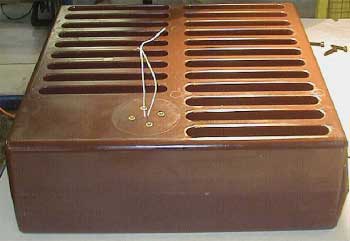 |
|
Fig. 1. VIEC element (size: 450 x 450 x 190 mm).
|
|
The VIEC has previously been tested on medium heavy crude oil (ranging from 20-32°API) with good results. The enhancement in separation has made new operational condition possible including:
- Reduced operational temperature
- Reduced retention time (or increased flowrates)
- Reduced consumption of de-emulsifier
- Increased tolerance to high upstream shear forces (stable emulsion and small droplets).
Even with the extra requirements on operational conditions, produced oil quality and water quality is high (less than 5% water-in-oil and less than 200-ppm oil-in-water, depending on operational parameters and crude).
The LOWACC is a supplementary electrostatic coalescer designed to operate downstream of the VIEC. It is based on the same principles as the VIEC, with isolated electrodes and an integrated transformer allowing operation in different fluids without shorting. The structural shape of the LOWACC, however, is different from VIEC: it has vertically-orientated electrodes and a complex, inhomogeneous electric field draws small water droplets together to coalesce into larger droplets.
The LOWACC improves oil quality and is a necessity where oil is extremely heavy or production conditions set strict requirements on water content to avoid hydrate formation. A large development project, DEMO2000, is ongoing and aims toward a full-scale offshore pilot installation of the LOWACC offshore in 2008.
THEORY
The main feature of electrostatic coalescers is the effect of the electrostatic field strength on conductive droplets (water) in an insulating media (oil). Water droplets in oil act as dipoles with a positive and a negative end. The electrostatic field from high-voltage between two electrodes exerts a force on the droplets that presses them together and helps drain film between them, which enhances coalescence to larger droplets.
It is well known that separation of water from oil is governed by size of the water droplets. Using Stokes Law as an approximation, the terminal fall velocity of a droplet is proportional to the square of the droplet’s diameter. That is, the larger the droplets, the faster the separation process.
Therefore, it is advantageous to have a droplet size distribution with predominantly large droplets coming into the separator vessel. The droplet-size distribution is governed by the shear history of the oil-water mixture prior to the separator vessel, and is therefore hard to control. Introducing an electric field inside the separator vessel is a potential remedy to this difficulty.
The dielectrophoretic force is not directly dependent on the presence of surrounding droplets and is proportional to the electric field gradient. Several experiments have shown that the dielectrophoretic force can be controlled and can thereby enable droplet migration in preferred directions.
MOBILE SEPARATOR
Development of coalescer elements was performed in Aibel’s in-house lab. The qualification of concepts, prototypes and final design was performed with a three-phase test separator, Fig. 2. The separator is made of duplex steel and is mounted in a mobile skid with all necessary instrumentation and control valves, and has various sample points for extraction of fluid samples, Fig. 3.
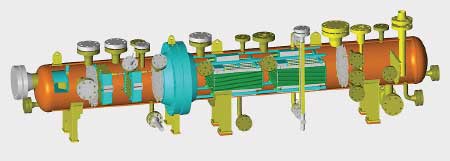 |
|
Fig. 2. Test separator with internal electrostatic coalescers.
|
|
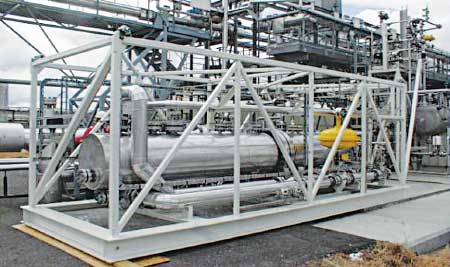 |
|
Fig. 3. Mobile test separator skid.
|
|
The separator is a long and slender tank with a total length of 5 m, and an internal diameter of 630 mm, yielding an L/D ratio of about 8. The system is designed to handle up to 10,000 bpd of liquid. Design temperature is 125°C and design pressure is 100 bar, making it suitable for subsea operational conditions. The separator inlet is a low-momentum flow diverter. VIEC and LOWACC are installed in the separator to improve separation. Double perforated plates are installed upstream and downstream the VIEC element, creating three chambers in the separator (inlet, VIEC and LOWACC chambers).
The mobile test separator has been installed onshore as part of Norsk Hydro’s multiphase test rig in Porsgrunn, Norway, and makes multiphase testing possible with real offshore conditions and fluids. The rig consists of a reservoir, feed pumps, a compressor, a multiphase pump, instrumentation and a test separator with electrostatic internals including VIEC and LOWACC, Fig. 4. The test loop draws fluid from the reservoir where oil, water and gas are separately routed to feed pumps and compressors. The pumps and compressors deliver fluids according to set values based on desired gas-to-oil ratios, watercut and flowrates.
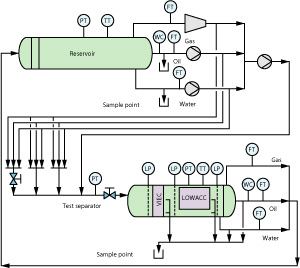 |
|
Fig. 4. Simplified schematic of the Norsk Hydro multiphase test loop.
|
|
The separate phases are then fed to downstream well mixing systems that simulate production with one, two or three wells to generate the most realistic production conditions possible, i.e., to create complex emulsions that often occur offshore.
The oil/water/gas mixture is then sent through a valve (simulating a choke), where high-shear forces create stable emulsions and small droplets before entering the mobile test separator. In the test separator, the internal electrostatic coalescer elements will increase the droplet size and break down the emulsion layer. At the outlet of the test separator, the mixture is routed back to the reservoir once more. The reservoir separates oil, water and gas used in the testing and delivers clean oil, water and gas to the feed pumps and compressor.
Achieving realistic testing conditions is possible with this rig, however, results can be conservative because fluid is circulated in the loop and very stable complex emulsions can be aggregated.
RESULTS AND DISCUSSION
Viscosity is a significant factor in heavy-oil separation. Heating is required to remove water from heavy oil emulsions, normally up to 100-120°C to reduce viscosity down to 10-15 cP. With active electrostatic coalescers in the three-phase separator, water removal can be obtained at much lower temperatures.
It is difficult to perform heavy oil tests in a flow loop, particularly because operating conditions are challenged by high flowrates, high shear and high viscosity. A VIEC is installed in the reservoir to be able to control the input to the test line.
A large number of tests were performed with 17°API oil. Almost no separation was observed without voltage application to the coalescer elements. The wide span of operating oil viscosities only partly influenced separation performance as long as voltage was on.
A significant separation could be achieved at viscosities three to four times higher than those used in field operations. The test series shows influence of upstream shear over a choke valve, Fig. 5. A fully open choke valve allows the best separation, as oil can be processed to below 5% water-in-oil within 4 min. retention time for up to 80 cP viscosity of oil. Applying up to 10-bar pressure loss over the upstream choke reduces oil quality to some extent. In these tests, it should be noted that use of an inline multiphase pump was necessary to cope with the total pressure loss in the loop, which has a negative effect on emulsion stability, since shear in the pump generates very small droplets. Some of these small droplets may pass the test line and reservoir, resulting in a shift in droplet size distribution toward a smaller diameter. The loop tests are thus conservative, and the absolute numbers for oil quality may be further improved in field installations where emulsion passes only once.
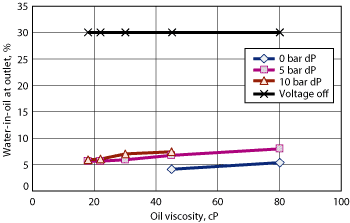 |
|
Fig. 5. Oil quality for different shear histories.
|
|
CONCLUSION
The oil tests have demonstrated the vast improvement in separation possible with coalescers. Processing oil at a lower temperature (higher viscosity) with VIEC and LOWACC in HP separators may help overcome bottlenecks and provide a solution to heater duty limitations. Using the VIEC and LOWACC on lighter oil such as 29°API crude has been effective-even without use of any chemicals where it is experimentally verified that one-stage separation is possible with the coalescer elements introduced to the three-phase separator.
For both light and heavy oil tests, a proper separation can take place with or without highly-reduced chemical amounts, which is beneficial from a cost and environmental point of view. VIEC and LOWACC have a positive effect on the produced water quality that gets better by increased residence time in the LOWACCs. For most test cases, water quality could be improved by several orders of magnitude by turning the coalescer elements on. Operational improvements can be experienced in field installations due to demulsifier concentration reduction. Also, the sharp interface level improves the level control and may ensure more steady flowrates to the downstream hydro-cyclones. 
ACKNOWLEDGEMENTS
The financial support from the Norwegian Research Council and assistance from Norsk Hydro’s and Statoil’s research center in Porsgrunn is gratefully acknowledged.
BIBLIOGRAPHY
Wolff, E. A. and T. L. Knutsen, “Advanced electrostatic internals in the 1st stage separator enhance oil/water separation and reduce chemical consumption on the Troll C platform,” OTC 16321 presented at the Offshore Technology Conference, Houston, Texas, USA, May 3-6, 2004.
Kvilesjø, B. E. et al., “Subsea separation process qualified for heavy oils (17°API),” presented at the Deep Offshore Technology Conference and Exhibition, Vitoria, Espirito Santo, Brazil, November 8-10, 2005.
Mosland A. M. et al., “VIEC (Vessel Internal Electrostatic Coalescer) - A proven technology for enhancing heavy oil separation and improving produced water quality,” presented at the Advances in Multiphase Separation and Multiphase Pumping Technologies Conference, Aberdeen, United Kingdom, September 1-2, 2005.
Chisea M., Melheim, J. A., Pedersen, A., Ingebrigsten, S. and G. Berg, “Forces acting on water droplets falling in oil under the influence of an electric field: numerical predictions versus experimental observations,” European Journal of Mechanics B/Fluids 24, 2005, pp. 717-732.
Pohl H. A., “Dielectrophoresis,” Cambridge University Press, Cambridge, UK, 1978.
Adamczyk, Z., Para, G., Piasecki, W., Nilsen, P. J., Nowak, P. and P. Warszynski, “Interactions of aqueous drops with electrodes in dielectric liquids,” Bulletin of the Polish Academy of Sciences Chemistry, 51, No. 3, 2003, pp. 423-434.
Fjeldly, T. A., Hansen, E. B. and P. J. Nilsen, “Novel coalescer technology in first stage separator enables one-stage separation and heavy-oil separation,” OTC 18278 presented at Offshore Technology Conference, Houston, Texas, May 1-4, 2006.
|
THE AUTHOR
|
|
|
Matteo Chiesa is a professor at the Masdar Institute of Science and Technology (MIST) in Abu Dhabi. MIST is a graduate-level, scientific engineering institution focused on education research in the core energy and sustainability-technology themes of the Masdar Initiative. He previously worked at the Massachusetts Institute of Technology (MIT), investigating properties of insulating materials developed in collaboration with Aibel. He was also employed at SINTEF Petroleum and Energy, working on projects related to gas transport and processing. Dr. Chiesa earned his PhD in applied mechanics from the Norwegian University of Science and Technology in 2001.
|
|
|








